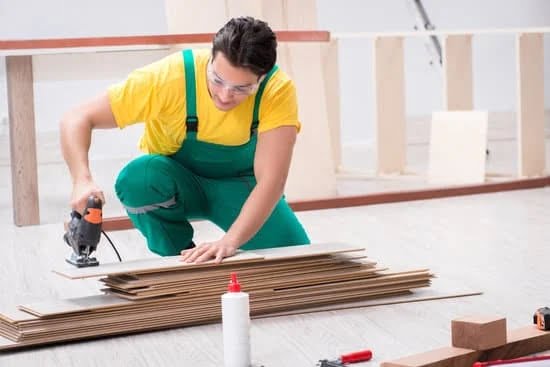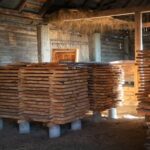Woodworking tools are essential for any woodworking enthusiast, but over time, they can develop rust that hampers their performance and durability. In this article, we will explore the importance of cleaning rust off woodworking tools and provide a comprehensive guide on how to do so effectively. Regular maintenance and cleaning play a crucial role in preserving the quality and lifespan of these tools, ensuring optimal performance with every use.
Rust is the nemesis of woodworking tools, causing them to become dull, less efficient, and even prone to breakage. This corrosive process occurs when iron or steel comes into contact with moisture or oxygen, resulting in the formation of iron oxide.
Not only does rust create an unattractive appearance on your tools, but it can also compromise their functionality by creating rough surfaces or interfering with moving parts. Therefore, it is vital to address rust as soon as it appears and take proactive measures to prevent its recurrence.
Effective maintenance and cleaning practices are key to preventing rust from ruining your woodworking experience. By regularly removing rust buildup from your tools, you not only ensure their longevity but also maintain their sharpness and precision.
Neglecting this aspect can lead to costly replacements or compromised results in your woodworking projects. The following sections will delve into various aspects of rust removal and prevention techniques so that you can keep your woodworking tools in top-notch condition for years to come.
Understanding Rust on Woodworking Tools
Rust is a common problem that woodworkers face when it comes to their tools. Understanding what rust is and how it forms on woodworking tools is crucial in effectively preventing and addressing this issue.
Rust, also known as iron oxide, occurs when metal is exposed to moisture and oxygen over time. When moisture comes into contact with the surface of the metal, it creates a chemical reaction that leads to the formation of rust. This can be particularly problematic for woodworking tools because they are often exposed to high levels of humidity in workshops or storage areas.
Several factors contribute to the development of rust on woodworking tools. Firstly, the type of material used for the tool plays a significant role. For example, carbon steel tends to be more susceptible to rust compared to stainless steel due to its higher iron content. Additionally, leaving tools exposed to moisture for extended periods can accelerate the formation of rust. Inadequate storage conditions such as high humidity levels can also increase the likelihood of rust development.
To address and prevent rust on woodworking tools, it is important to gather the necessary supplies for cleaning. A thorough and effective cleaning process requires specific products and tools designed for rust removal. Some essential supplies include:
- Rust remover solution: Look for commercial rust remover products that are specifically formulated for use on metal surfaces.
- Wire brush or steel wool: These abrasive materials can help remove loose rust particles from the surface of the tool.
- Fine-grit sandpaper: Ideal for lightly sanding away any remaining rust after using a wire brush or steel wool.
- Clean rags or paper towels: These are needed for wiping down the tool during and after cleaning.
- Protective gear: It is crucial to wear safety goggles and gloves when handling chemicals or abrasive materials during the cleaning process.
- Lubricating oil: After removing rust, applying a thin layer of lubricating oil will help prevent future oxidation.
By understanding how rust forms on woodworking tools and gathering the necessary supplies, woodworkers can effectively address rust issues and prevent further damage to their valuable tools. Taking the time to regularly clean and maintain woodworking tools will not only extend their lifespan but also ensure optimal performance during projects.
Gather the Necessary Supplies
When it comes to cleaning rust off woodworking tools, having the right supplies is crucial for effective and efficient removal. Here is a detailed list of the supplies you will need to gather before starting the rust removal process:
- Rust Dissolver: A good quality rust dissolver or rust remover is essential for breaking down and removing the rust from your tools. Look for a product that is specifically formulated for use on metal surfaces.
- Brushes: Different types of brushes will be needed depending on the size and type of tool you are cleaning. Wire brushes with stiff bristles are ideal for removing large areas of rust, while smaller brass or nylon brushes can be used for more delicate areas.
- Scraper: A scraper tool can be handy for scraping off larger patches of rust that are difficult to remove with a brush alone. Look for a scraper with a comfortable grip and replaceable blades.
- Sandpaper or Emery Cloth: Coarse-grit sandpaper or emery cloth can be used to smooth out any rough spots left after rust removal and prepare the surface for further treatment if necessary.
- Protective Gear: It is important to protect yourself during the cleaning process, especially when working with chemicals or using mechanical methods such as wire brushing. Wear gloves, safety glasses, and a mask to prevent contact with potentially harmful substances.
- Cleaning Solvent: A mild cleaning solvent can be used to remove grease, oil, or other contaminants from your tools before applying the rust remover. Use a solvent that is safe for use on metal surfaces and follow the manufacturer’s instructions.
- Cloths/Towels: Soft cloths or towels will come in handy for wiping away excess rust remover, cleaning solvent, and any debris that may accumulate during the process.
- Lubricant: After removing rust from your woodworking tools, it is important to apply a protective lubricant such as oil or wax to prevent future rust formation. Choose a lubricant that is specifically designed for woodworking tools and follow the manufacturer’s instructions.
By gathering these supplies before starting the rust removal process, you will be well equipped to successfully clean your woodworking tools and restore them to their optimal condition. Remember to always read and follow the instructions provided by the manufacturers of both the supplies and the tools being cleaned to ensure safety and optimal results.
Preparing the Tools for Cleaning
To effectively clean rust off woodworking tools, it is crucial to properly prepare the tools before starting the cleaning process. By taking a few necessary steps, you can ensure that the cleaning is efficient and safe. Here are the steps for preparing the rusted tools for cleaning:
- Remove any dirt and debris: Before you begin tackling the rust, it’s important to remove any loose dirt or debris from the surface of the tools. This can be done by wiping them down with a clean cloth or using a soft-bristle brush to loosen any stubborn particles.
- Disassemble if necessary: Some woodworking tools may have multiple parts or removable blades that need individual attention. If this is the case, disassembling the tool will allow for better access to all areas affected by rust.
- Apply penetrating oil: For heavily rusted tools, applying a penetrating oil can help loosen and dissolve stubborn rust. Simply apply a generous amount of penetrating oil onto the rusty areas and let it sit for a few hours or overnight, depending on the severity of the rust.
- Protect movable parts: If your woodworking tool has movable parts such as hinges or triggers, it’s essential to protect them during the cleaning process. You can do this by wrapping those parts with masking tape or applying a layer of petroleum jelly to prevent damage from any cleaning agents or abrasive materials.
- Use safety precautions: When dealing with rust removal products or power tools during this process, it’s important to prioritize safety. Wear protective gloves and goggles to shield yourself from any potential harm and work in a well-ventilated area if using chemical-based cleaners.
By following these steps, you can ensure that your woodworking tools are properly prepared for effective rust removal while also keeping yourself safe during the cleaning process.
Suggested Supplies
To prepare your tools for cleaning and effectively remove rust from them, here are some supplies you will need:
- Rubber gloves: These will protect your hands from any chemicals or abrasive materials.
- Safety goggles: Make sure to wear safety goggles to protect your eyes from any potential debris or cleaning agents.
- Clean cloth or soft-bristle brush: These will be used to remove any loose dirt or debris from the surface of the tools.
- Penetrating oil: A good-quality penetrating oil, such as WD-40, is essential for loosening and dissolving stubborn rust.
- Masking tape or petroleum jelly: Use these to protect movable parts such as hinges or triggers from damage during the cleaning process.
- a. Vinegar: An affordable and eco-friendly option, vinegar can help dissolve light rust on woodworking tools.
- b. Citric acid solution: If vinegar alone isn’t effective, you can mix citric acid powder with water to create a solution that is more potent against rust.
- c. Commercial rust removers: There are various commercial rust removal products available that are specifically formulated for removing rust from metal surfaces. Look for products that are safe to use on woodworking tools.
- a. Steel wool or wire brush: These abrasive materials are effective for scrubbing away rust from the surface of woodworking tools.
- b. Sandpaper: Medium-grit sandpaper can be used to remove lighter rust or smooth out any rough spots after the initial cleaning.
- Container for soaking (if necessary): Depending on the size of your tools and the severity of rust, you may need a container large enough to soak them in cleaning solutions like vinegar or citric acid solution.
6. Cleaning agent options:
7. Abrasive materials:
By gathering these supplies beforehand, you can ensure that you have everything necessary to properly prepare your woodworking tools for cleaning and effectively remove rust from them.
Methods for Cleaning Rust Off Woodworking Tools
Chemical-Based Methods
One effective method for cleaning rust off woodworking tools is to use chemical-based solutions. There are several commercially available rust removers that can dissolve and remove rust from the surface of tools. One popular option is a phosphoric acid-based rust remover. This type of product works by converting the iron oxide in rust into a stable compound, making it easier to remove.
To clean rust off your woodworking tools using a chemical-based method, start by applying the rust remover onto the affected areas. Follow the instructions on the product label for specific application techniques and safety precautions. Typically, you will need to brush or spray the solution onto the rusted surface and let it sit for a specified amount of time to allow it to penetrate and dissolve the rust.
After allowing sufficient time for the solution to work, scrub off any remaining rust using a scrub brush or steel wool. Rinse the tool thoroughly with clean water and dry it completely before moving on to the next step in your restoration process. It is important to note that some chemical-based methods may require multiple applications or additional steps such as neutralizing or rinsing with a second solution.
Mechanical Methods
Another option for cleaning rust off woodworking tools is to utilize mechanical methods. These methods involve physically removing the rust using abrasive materials or tools. One commonly used mechanical method is sanding, which involves using sandpaper or an abrasive pad to scrub away the rusty layer until you reach clean metal.
To use sanding as a method for removing rust, start by selecting an appropriate grit of sandpaper based on the severity of the rust and desired finish. Begin by sanding in circular motions over the rusty areas until all traces of rust have been removed. It may be helpful to periodically wipe away any debris with a damp cloth to assess your progress.
Once all visible signs of rust have been eliminated, switch to a finer grit of sandpaper to smooth out the sanded areas and restore a polished finish. It is important to note that sanding can be time-consuming and may require additional steps, such as polishing or buffing, to achieve the desired result.
Electrolytic Methods
For more severe cases of rust on woodworking tools, an effective method is the use of electrolysis. Electrolytic rust removal works by passing an electric current through a solution, causing the rust to be dissolved and transferred from the tool’s surface to a sacrificial metal object. This method is particularly suitable for complex or heavily rusted tools.
To clean rust off woodworking tools using electrolysis, you will need a plastic container large enough to submerge your tools, a sacrificial metal object (such as steel), water, and washing soda (sodium carbonate). Fill the plastic container with a mixture of water and washing soda, making sure there is enough solution to completely submerge your rusty tools.
Attach the positive terminal of a battery charger to your rusty tool and connect the negative terminal to the sacrificial metal object. Submerge both objects in the solution without them touching each other. Turn on the battery charger and allow electrolysis to take place for several hours or overnight.
After electrolysis is complete, remove your tools from the solution and scrub away any remaining rust using a wire brush or steel wool. Rinse your tools thoroughly with clean water and dry them completely before proceeding with any further restoration or protective measures.
Tips for Preventing Rust on Woodworking Tools
Proper Storage Techniques
One of the most important factors in preventing rust on woodworking tools is proper storage. When not in use, it is crucial to store your tools in a dry and controlled environment. Moisture is the primary culprit of rust formation, so ensuring your tools are kept away from damp areas is vital. Consider investing in a tool cabinet or box with airtight seals to protect your tools from humidity and moisture.
Humidity Control
Controlling the humidity level in your workspace is another effective way to prevent rust on woodworking tools. High humidity levels can create a conducive environment for rust formation. Consider setting up a dehumidifier or using desiccant packs within your tool storage to absorb excess moisture in the air. Additionally, utilizing silica gel packets can help reduce the chances of rust by absorbing any moisture that may be present.
Surface Treatment Options
Treating the surfaces of your woodworking tools can provide an added layer of protection against rust. There are various surface treatment options available, including applying a protective coating or using corrosion inhibitors. Some woodworkers may choose to apply a thin layer of oil, such as mineral oil or Boeshield T-9, onto their tools’ surfaces after each use to prevent moisture contact and inhibit rust formation.
Other options include using wax-based coatings or specialized rust prevention sprays. It’s essential to research and choose the treatment option that best suits your needs and preferences.
By implementing these tips for preventing rust on woodworking tools, you can significantly extend their lifespan and maintain their performance over time. Remember that regular maintenance, including cleaning off sawdust and debris after each use, inspecting for signs of corrosion regularly, and promptly addressing any concerns will help keep your tools in optimal condition for years to come.
Restoring and Preserving Woodworking Tools
Once you have successfully removed the rust from your woodworking tools, it is important to take additional measures to restore and preserve their functionality. It’s not enough to simply remove the rust; proper maintenance is essential to ensure that your tools remain rust-free and in optimal condition for years to come.
One key step in restoring and preserving woodworking tools is lubrication. After cleaning off the rust, apply a thin layer of lubricant to the metal surfaces of your tools. This will help prevent future rust formation by creating a barrier between the metal and moisture in the air. Be sure to use a lubricant specifically designed for woodworking tools, such as a silicone-based product or a wax-based solution.
Sharpening your woodworking tools is another crucial aspect of restoration and preservation. Over time, the edges of your tools may become dull or damaged due to rust or wear. Sharpening them regularly will not only improve their performance but also extend their lifespan. Use sharpening stones or files appropriate for the specific tool you are sharpening, following manufacturer guidelines if available.
In addition to lubrication and sharpening, ongoing maintenance is essential for keeping your woodworking tools in top shape. This includes regular cleaning after each use, which helps prevent any residual moisture or debris from causing damage over time. Consider using a soft cloth or brush to wipe down your tools before storing them away.
Proper storage is also crucial for preserving your restored woodworking tools. Store them in a clean, dry area with controlled humidity levels. If possible, consider investing in a dedicated tool cabinet or case that protects them from dust and moisture when not in use.
By following these steps for restoring and preserving your woodworking tools after removing rust, you can ensure they remain functional and reliable for many future projects.
| Tool Restoration Steps | Benefits |
|---|---|
| Lubrication | Prevents future rust formation |
| Sharpening | Improves tool performance and extends lifespan |
| Ongoing Maintenance | Prevents damage from moisture and debris |
| Proper Storage | Preserves tools from dust and moisture |
Recommendations for Rust Removal Products and Tools
One of the key steps in effectively cleaning rust off woodworking tools is using the right products and tools for the job. Here are some recommended rust removal products and tools that have proven to be effective:
- Rust Dissolver or Remover: These chemical-based products are specifically designed to dissolve rust and make it easier to remove from metal surfaces. They often come in gel or liquid form and can be applied directly to the rusty areas. Some popular rust dissolvers include WD-40 Rust Remover Soak, Evapo-Rust, and Naval Jelly.
- Wire Brushes: Wire brushes are essential for removing loose rust particles from tools. They come in a variety of designs, such as hand-held brushes with bristles of different thicknesses, wire wheels for use with power tools, and rotary brushes that attach to drills. It’s recommended to use brass or stainless steel wire brushes to avoid scratching or damaging the metal surface.
- Sandpaper or Emery Cloth: For more stubborn rust spots, sandpaper or emery cloth can be used to manually sand away the rust until a smooth surface is achieved. Start with a coarse grit (around 80-grit) and gradually move to finer grits (up to 320-grit) for a polished finish.
- Rust Converter: Rust converters are chemical solutions that convert iron oxide (rust) into a stable compound that protects against further corrosion. They work by creating a black barrier on the metal surface, which also acts as a primer for paint if desired. Popular rust converter brands include Corroseal and Loctite Extend Rust Neutralizer.
- Lubricating Oil: Once the rust has been removed, it’s important to lubricate the woodworking tools to prevent future corrosion. Choose a high-quality lubricating oil specifically formulated for tool maintenance, such as Boeshield T-9 or 3-IN-ONE Multi-Purpose Oil.
It’s worth noting that personal preferences and the extent of rust on your woodworking tools may dictate which products and tools work best for you. It’s always a good idea to read product instructions carefully before using them, as some chemicals may require additional safety precautions such as proper ventilation or gloves.
Conclusion
In conclusion, the importance of maintaining rust-free woodworking tools cannot be overstated. Rust not only affects the appearance of tools but also compromises their functionality and lifespan. By regularly cleaning and properly maintaining these tools, woodworkers can ensure that they remain in top condition for years to come.
Throughout this article, we have discussed the negative impact of rust on woodworking tools and highlighted the significance of regular maintenance and cleaning. We have explored what rust is and how it forms on tools, as well as various factors that contribute to its development. Understanding these aspects is crucial in effectively preventing and removing rust from woodworking tools.
To clean rust off woodworking tools, it is important to gather the necessary supplies, such as specific products and tools that are effective for rust removal. Additionally, proper preparation of the rusted tools is essential before starting the cleaning process, including taking safety precautions. The article has provided step-by-step instructions for different methods of rust removal, both chemical-based and mechanical options, along with their pros and cons.
Furthermore, we have shared practical tips for preventing rust from forming in the future. Proper storage techniques, humidity control, and surface treatment options play a significant role in keeping woodworking tools rust-free. After removing the rust, it is crucial to restore and preserve the functionality of these tools through proper lubrication, sharpening, and regular maintenance.
Frequently Asked Questions
How do you remove rust from workshop tools?
To remove rust from workshop tools, there are several methods you can consider. One approach is to use a wire brush or steel wool to scrub away the rust manually. Begin by removing any loose rust flakes and then vigorously scrub the tool’s surface until the rust is gone.
Another method involves using a chemical rust remover, available in most hardware stores. These solutions typically contain acid that breaks down the rust, allowing you to wipe it off easily. Be sure to follow the manufacturer’s instructions carefully when using these products and take appropriate safety precautions such as wearing gloves and eye protection.
What is the easiest way to remove rust from tools?
The easiest way to remove rust from tools is by utilizing a product specifically designed for this purpose: rust dissolver spray. Using this method is relatively simple as all you need to do is spray the solution onto the affected areas of your tools, allow it to sit for a few minutes according to the instructions provided, and then wipe away the loosened rust with a cloth or paper towel.
This method works particularly well for light or surface-level rusting, making it highly convenient and efficient.
What is the best solution to soak rusting tools in?
When it comes to soaking rusting tools, there are numerous options available depending on what you have readily accessible. White vinegar is often recognized as an effective solution due to its acidic properties that help dissolve stubborn rust buildup over time. Simply submerge your tools in white vinegar for several hours or even overnight, ensuring they are fully covered by the liquid.
Afterward, scrub off any remaining loosened rust with a wire brush or steel wool before thoroughly rinsing and drying the tools to prevent further oxidation. Other possible soaking solutions include lemon juice or specialized commercial rust removers which can be diluted according to their instructions but may require caution when handling due to their chemical composition.

Hi everyone! I’m a woodworker and blogger, and this is my woodworking blog. In my blog, I share tips and tricks for woodworkers of all skill levels, as well as project ideas that you can try yourself.





